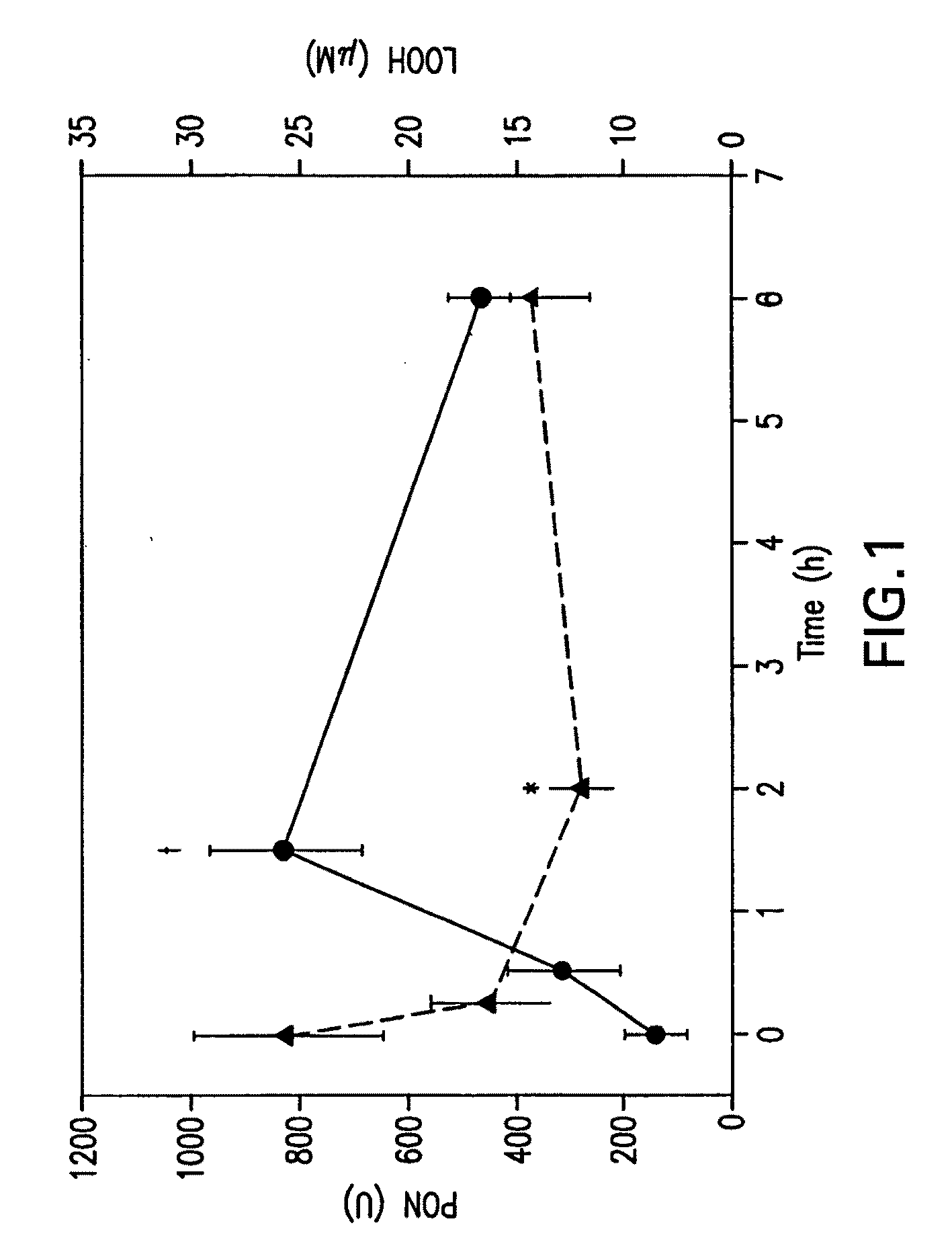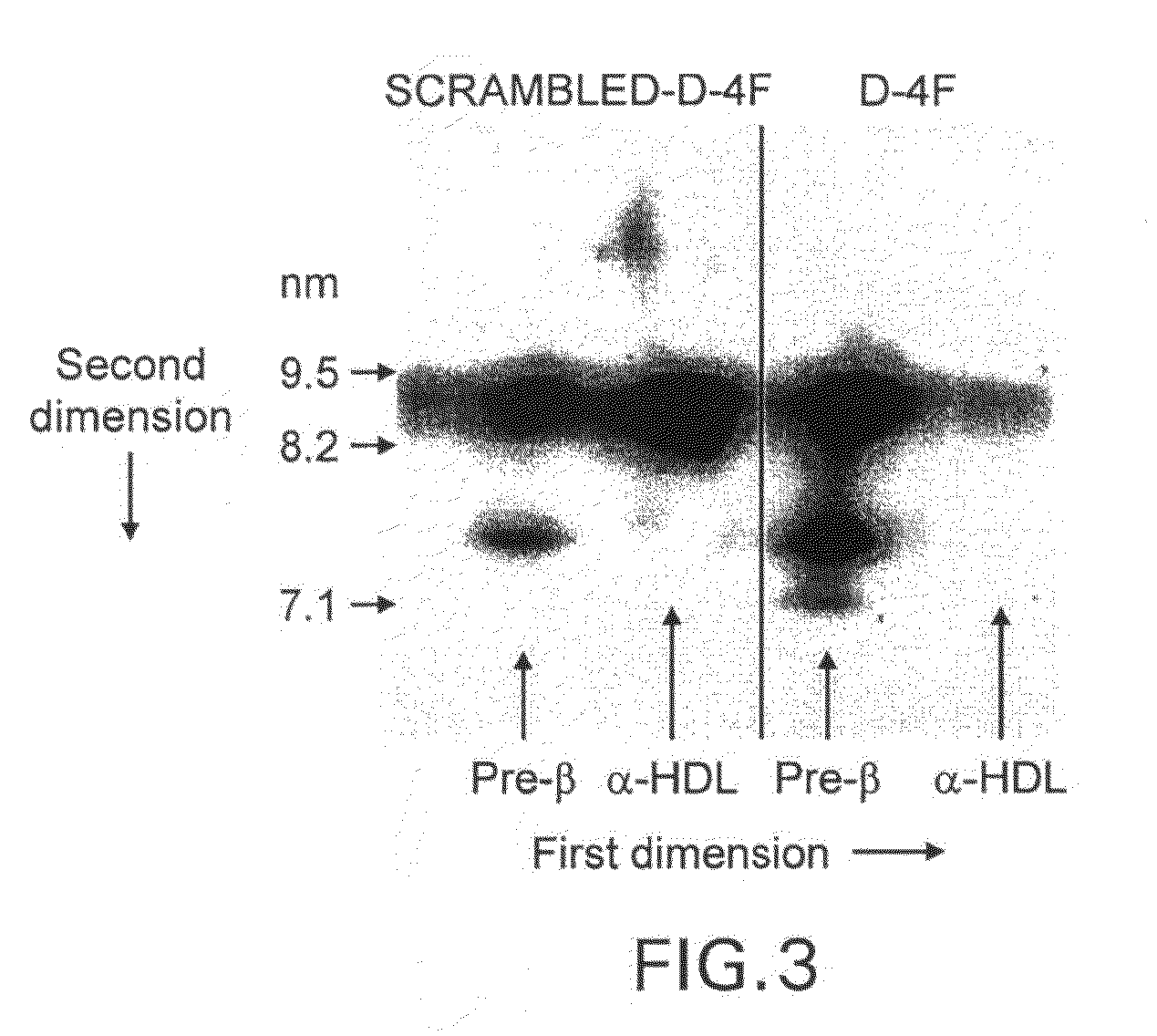Synthetic apolipoprotein e mimicking polypeptides and methods of use
a polypeptide and synthetic technology, applied in the field of synthetic peptides, can solve the problems of dm, major morbidity and mortality, decompensation and chronic hyperglycemia, etc., and achieve the effect of decreasing the concentration of plasma glucos
- Summary
- Abstract
- Description
- Claims
- Application Information
AI Technical Summary
Problems solved by technology
Method used
Image
Examples
example 1
[0181]Previuous studies have been conducted with the apo mimetic peptides (4F, Ac-hE18A-NH2) that have demonstrated their anti-oxidant and anti-inflammatory properties. The effects of Ac-hE18A-NH2 in improving endothelial function in WHHL rabbits have also been demonstrated previously (Gupta H et al., Circulation. (2005): 111(23):3112-8). These rabbits have defective LDL receptors and therefore have increased atherogenic lipoproteins (mainly LDL). It was found that a single administration of Ac-hE18A-NH2 peptide resulted in dramatic decrease in total and LDL cholesterol. This was associated with improved aortic endothelial function. This improvement in endothelial function was mediated in part by increase in PON activity with associated decrease in plasma lipid hydroperoxide (FIG. 1). FIG. 1 also shows WHHL rabbits have defective LDL receptor and are therefore prone to atherosclerosis due to dyslipidemia. PON is an anti-oxidant enzyme associated with HDL and is responsible for scave...
example 2
[0188]Whether apo A-I, HDL lipoproteins and apo-mimetic peptides (4F, Ac-hE18A-NH2) that modulate HDL function can inhibit the onset and progression of DM-2 in rodent models can also be determined. DM-2, as previously described, is characterized by low HDL-C levels with poor HDL quality. This is reflected by impaired anti-inflammatory and anti-oxidant effects. These changes are seen early in the disease process where insulin resistance without elevation in the plasma glucose is noted. Inflammation and oxidant stress are important mediators of insulin resistance. These mechanisms eventually lead to decrease in pancreatic β-cell mass in later stages of DM-2. There are many rodent models of DM-2. ZDF rats with defective leptin receptor are commonly used models of insulin resistance and DM-2. These animals are hyperleptinemic but show impaired leptin actions. Homozygous ZDF (fa / fa) male rats develop insulin resistance early on and when fed a standard diet these animals, demonstrate hype...
example 3
[0190]As previously described, preliminary observations support the anti-diabetic effects of the apo-mimetic peptides. These effects of the peptides are likely due to three major mechanisms: (i) improved insulin secretion; (ii) decrease in pancreatic β-cell apoptosis or cell death; and / or (iii) improved insulin sensitivity of peripheral tissues. These effects of the peptides are mediated by their anti-inflammatory, anti-oxidant and reverse cholesterol promoting mechanisms and are summarized in FIGS. 5 and 6. As such, whether apo A-I, HDL and apo-mimetic peptides (4F and Ac-hE18A-NH2) prevent apoptosis in pancreatic β-cells, whether apo A-I, HDL and apo-mimetic peptides (4F and Ac-hE18A-NH2) improve peripheral insulin sensitivity, and whether apo A-I, HDL and apo-mimetic peptides (4F and Ac-hE18A-NH2) promote reverse cholesterol transport can also be studied.
PUM
| Property | Measurement | Unit |
|---|---|---|
| temperature | aaaaa | aaaaa |
| pH | aaaaa | aaaaa |
| pH | aaaaa | aaaaa |
Abstract
Description
Claims
Application Information
 Login to View More
Login to View More - R&D
- Intellectual Property
- Life Sciences
- Materials
- Tech Scout
- Unparalleled Data Quality
- Higher Quality Content
- 60% Fewer Hallucinations
Browse by: Latest US Patents, China's latest patents, Technical Efficacy Thesaurus, Application Domain, Technology Topic, Popular Technical Reports.
© 2025 PatSnap. All rights reserved.Legal|Privacy policy|Modern Slavery Act Transparency Statement|Sitemap|About US| Contact US: help@patsnap.com



